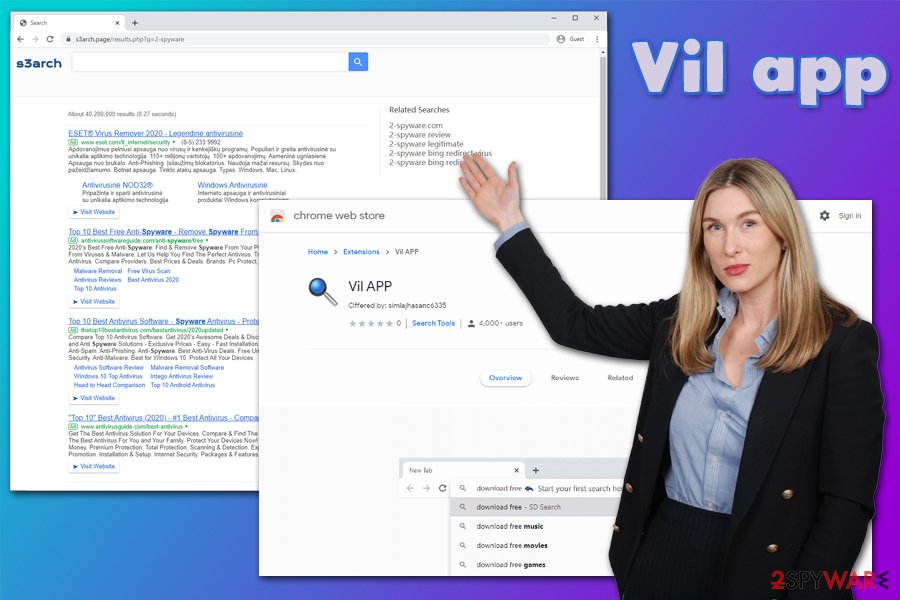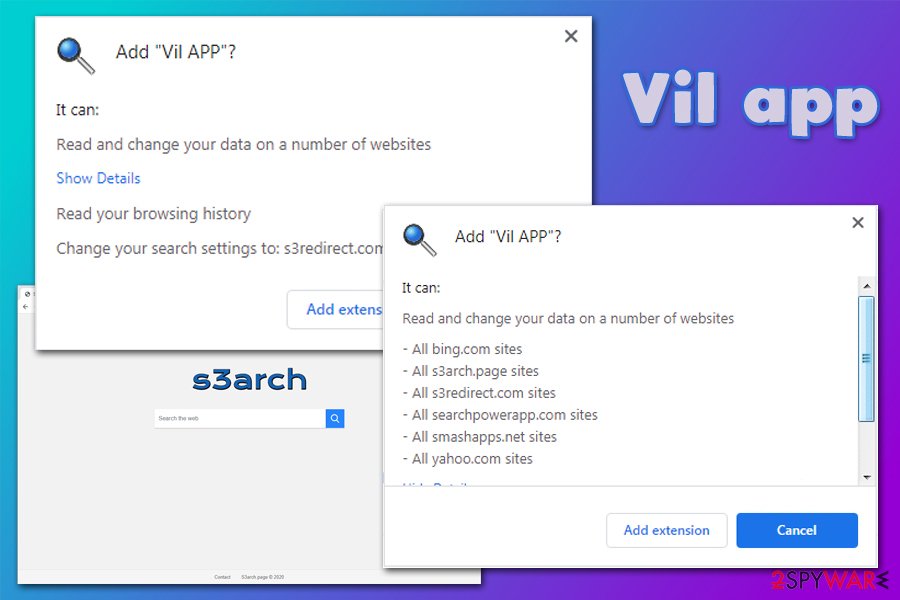Vil app (Removal Guide) - Free Instructions
Vil app Removal Guide
What is Vil app?
Vil app – a potentially unwanted program that redirects browser searches to suspicious sites

Vil app is yet another browser hijacker[1] that is designed to change web browser settings without permission. While the Google Chrome extension can be downloaded from its official store, it might also be distributed via less secure sources, including fake updates, fraudulent advertisements, or software bundle packages that are downloaded from third-party sites that distribute freeware.
Once inside the system, a Vil app extension/add-on will be installed, and the homepage, as well as the new tab URL, will be altered to a different one. Besides, all the searches will be transferred to other sources, such as Yahoo, Bing, s3arch, or another one. The app will also show a bunch of sponsored links and will track online user activities to benefit financially from targeted ads.
| Name | Vil app |
| Type | Browser hijacker, potentially unwanted program |
| Distribution | While a browser hijacker can be installed via legitimate sources, such as Google Web store, although most encounter the PUP after they download freeware apps from third-party sources or after they get tricked by an attractive or deceptive ad |
| Symptoms | Vil app and/or other unknown extensions installed on the browser; new tab and homepage address altered to something different; all searches are redirected to Yahoo, Bing, s3arch.page, s3redirect.com, or similar sites; search results are filled with sponsored links |
| Dangers | Installation of other PUPs, financial losses, personal information disclosure to unknown parties (privacy risks), etc. |
| Elimination | You can get rid of unwanted apps as per instructions below or perform a full system scan with anti-malware software |
| Optional steps | In case the termination of some browser extensions is difficult, we recommend resetting all the installed browsers, as explained below. Additionally, if malware/adware was found on the system, you could attempt to fix virus damage with tools like FortectIntego |
Browser hijackers such as Vil app are very common and are considered to be a minor browser infection. Nonetheless, the developers of PUPs often abuse less IT-savvy individuals in order to fill their browsers with sponsored content and profit from such deceptive activities.
The problem is that many users are not even aware that the Vil app hijack has occurred, and they continue browsing the web as previously. However, there are multiple symptoms that the unwanted apps exhibit, so they are relatively easy to spot. The reason why PUPs are not noticed is mainly due to the deceptive infiltration techniques, which often rely on software bundling.
As soon as Vil APP is installed on the web browser, it can perform the following:
- Change the default search engine to something else;
- Redirect all searches to s3redirect.com, or another untrustworthy site;
- Fill search results with sponsored links and ads;
- Read and change data on a number of websites, etc.
Possibly one of the most distinctive features of a browser hijacker such as Vil APP is its tendencies to display dozens of sponsored links at the top of search results. While such content is often indicated as an ad, many do not notice such markings and click on the very first result that is presented to them. Due to this, users visit less trustworthy websites that sometimes might even be dangerous. However, this is not the only reason to remove Vil APP for good.
The application also uses a variety of tracking technologies (web beacons,[2] cookies, JavaScript, etc.) to spy on users' online activities – this often prompts them to call it the Vil app virus. Although the term is not technically correct, malware often uses a variety of techniques to track users, although, in the case of the latter, sensitive data such as passwords are more commonly collected.

While the Vil app will not collect your passwords or banking data, it will gather a variety of details about your online behavior. For example, it will track your IP address, internet service provider (ISP), technical data, installed apps, search queries, language, timestamps, device location (in a mobile device is used), etc.
Thus, if you value your privacy and want to get rid of the annoying sponsored links, we suggest you perform Vil app removal immediately. For that, all you have to do is right-click on the extension within the web browser. If the add-on is not visible, you will have to enter the settings of your web browser or reset it completely. For more details, refer to the bottom section of this article.
Note: Vil app might not be the only PUP or malicious program installed on your system. In such a case, its termination might not stop ads, redirects, and other unwanted activities. You should then perform a full system scan with anti-malware and then FortectIntego or similar repair tools for the best results.
Watch out for software bundle packages – they are the leading cause of browser infections
As mentioned above, browser hijackers are not considered to major security threats, hence such apps can also be found on the official sources, such as Google Play. Nonetheless, security experts[3] and the infosec community have a different perspective on such application usage, as they could reduce the security of a machine, making it more prone to other infections. Besides, PUPs are often using deception to make users click on links, download software, or spend money. Thus, such apps should not be welcomed on any computer system.
However, staying away from potentially unwanted programs is relatively easy. Since PUPs are mainly distributed via software bundle packages, you should always pay close attention to the installation process of new apps, especially if they were downloaded from third party sources.
Before installing a new app, read up on it online – forum and blog posts can often serve as good indications for the program's security and reliability. When downloading new apps, never rush the installation process – ensure that the important documents (Privacy Policy, ToS) are provided, and the installation instructions are clear. Most importantly, always opt for advanced/custom settings when prompted (avoid recommended/quick ones), and eliminate all the ticks from the pre-ticked boxes.

Get rid of Vil app hijack
It is important to understand that Vil app removal is not only necessary because it would eliminate most of the sponsored links and ads from the web browser, but because it would also increase your online safety. Thus, if you noticed an unknown browser extension installed on your Google Chrome, Mozilla Firefox, MS Edge, Safari, or another web browser, you should immediately take action to get rid of it.
In most cases, you should be able to remove Vil app easily, all you have to do is right-click on the extension. If you can not see it, you should either reset the web browser, as explained below or access web browser settings. However, we highly recommend scanning the machine with anti-malware software to ensure that there are no other malicious programs installed on it.
You may remove virus damage with a help of FortectIntego. SpyHunter 5Combo Cleaner and Malwarebytes are recommended to detect potentially unwanted programs and viruses with all their files and registry entries that are related to them.
Getting rid of Vil app. Follow these steps
Uninstall from Windows
To get rid of potentially unwanted programs on Windows machines, follow these steps:
Instructions for Windows 10/8 machines:
- Enter Control Panel into Windows search box and hit Enter or click on the search result.
- Under Programs, select Uninstall a program.

- From the list, find the entry of the suspicious program.
- Right-click on the application and select Uninstall.
- If User Account Control shows up, click Yes.
- Wait till uninstallation process is complete and click OK.

If you are Windows 7/XP user, proceed with the following instructions:
- Click on Windows Start > Control Panel located on the right pane (if you are Windows XP user, click on Add/Remove Programs).
- In Control Panel, select Programs > Uninstall a program.

- Pick the unwanted application by clicking on it once.
- At the top, click Uninstall/Change.
- In the confirmation prompt, pick Yes.
- Click OK once the removal process is finished.
Delete from macOS
If you own a Mac, follow these instructions to get rid of PUPs:
Remove items from Applications folder:
- From the menu bar, select Go > Applications.
- In the Applications folder, look for all related entries.
- Click on the app and drag it to Trash (or right-click and pick Move to Trash)

To fully remove an unwanted app, you need to access Application Support, LaunchAgents, and LaunchDaemons folders and delete relevant files:
- Select Go > Go to Folder.
- Enter /Library/Application Support and click Go or press Enter.
- In the Application Support folder, look for any dubious entries and then delete them.
- Now enter /Library/LaunchAgents and /Library/LaunchDaemons folders the same way and terminate all the related .plist files.

Remove from Microsoft Edge
Delete unwanted extensions from MS Edge:
- Select Menu (three horizontal dots at the top-right of the browser window) and pick Extensions.
- From the list, pick the extension and click on the Gear icon.
- Click on Uninstall at the bottom.

Clear cookies and other browser data:
- Click on the Menu (three horizontal dots at the top-right of the browser window) and select Privacy & security.
- Under Clear browsing data, pick Choose what to clear.
- Select everything (apart from passwords, although you might want to include Media licenses as well, if applicable) and click on Clear.

Restore new tab and homepage settings:
- Click the menu icon and choose Settings.
- Then find On startup section.
- Click Disable if you found any suspicious domain.
Reset MS Edge if the above steps did not work:
- Press on Ctrl + Shift + Esc to open Task Manager.
- Click on More details arrow at the bottom of the window.
- Select Details tab.
- Now scroll down and locate every entry with Microsoft Edge name in it. Right-click on each of them and select End Task to stop MS Edge from running.

If this solution failed to help you, you need to use an advanced Edge reset method. Note that you need to backup your data before proceeding.
- Find the following folder on your computer: C:\\Users\\%username%\\AppData\\Local\\Packages\\Microsoft.MicrosoftEdge_8wekyb3d8bbwe.
- Press Ctrl + A on your keyboard to select all folders.
- Right-click on them and pick Delete

- Now right-click on the Start button and pick Windows PowerShell (Admin).
- When the new window opens, copy and paste the following command, and then press Enter:
Get-AppXPackage -AllUsers -Name Microsoft.MicrosoftEdge | Foreach {Add-AppxPackage -DisableDevelopmentMode -Register “$($_.InstallLocation)\\AppXManifest.xml” -Verbose

Instructions for Chromium-based Edge
Delete extensions from MS Edge (Chromium):
- Open Edge and click select Settings > Extensions.
- Delete unwanted extensions by clicking Remove.

Clear cache and site data:
- Click on Menu and go to Settings.
- Select Privacy, search and services.
- Under Clear browsing data, pick Choose what to clear.
- Under Time range, pick All time.
- Select Clear now.

Reset Chromium-based MS Edge:
- Click on Menu and select Settings.
- On the left side, pick Reset settings.
- Select Restore settings to their default values.
- Confirm with Reset.

Remove from Mozilla Firefox (FF)
Remove dangerous extensions:
- Open Mozilla Firefox browser and click on the Menu (three horizontal lines at the top-right of the window).
- Select Add-ons.
- In here, select unwanted plugin and click Remove.

Reset the homepage:
- Click three horizontal lines at the top right corner to open the menu.
- Choose Options.
- Under Home options, enter your preferred site that will open every time you newly open the Mozilla Firefox.
Clear cookies and site data:
- Click Menu and pick Settings.
- Go to Privacy & Security section.
- Scroll down to locate Cookies and Site Data.
- Click on Clear Data…
- Select Cookies and Site Data, as well as Cached Web Content and press Clear.

Reset Mozilla Firefox
If clearing the browser as explained above did not help, reset Mozilla Firefox:
- Open Mozilla Firefox browser and click the Menu.
- Go to Help and then choose Troubleshooting Information.

- Under Give Firefox a tune up section, click on Refresh Firefox…
- Once the pop-up shows up, confirm the action by pressing on Refresh Firefox.

Remove from Google Chrome
Browser hijackers and adware might leave traces on the web browser settings, even when the app itself gets eliminated. To fix this problem, reset Google Chrome:
Delete malicious extensions from Google Chrome:
- Open Google Chrome, click on the Menu (three vertical dots at the top-right corner) and select More tools > Extensions.
- In the newly opened window, you will see all the installed extensions. Uninstall all the suspicious plugins that might be related to the unwanted program by clicking Remove.

Clear cache and web data from Chrome:
- Click on Menu and pick Settings.
- Under Privacy and security, select Clear browsing data.
- Select Browsing history, Cookies and other site data, as well as Cached images and files.
- Click Clear data.

Change your homepage:
- Click menu and choose Settings.
- Look for a suspicious site in the On startup section.
- Click on Open a specific or set of pages and click on three dots to find the Remove option.
Reset Google Chrome:
If the previous methods did not help you, reset Google Chrome to eliminate all the unwanted components:
- Click on Menu and select Settings.
- In the Settings, scroll down and click Advanced.
- Scroll down and locate Reset and clean up section.
- Now click Restore settings to their original defaults.
- Confirm with Reset settings.

Delete from Safari
Remove unwanted extensions from Safari:
- Click Safari > Preferences…
- In the new window, pick Extensions.
- Select the unwanted extension and select Uninstall.

Clear cookies and other website data from Safari:
- Click Safari > Clear History…
- From the drop-down menu under Clear, pick all history.
- Confirm with Clear History.

Reset Safari if the above-mentioned steps did not help you:
- Click Safari > Preferences…
- Go to Advanced tab.
- Tick the Show Develop menu in menu bar.
- From the menu bar, click Develop, and then select Empty Caches.

After uninstalling this potentially unwanted program (PUP) and fixing each of your web browsers, we recommend you to scan your PC system with a reputable anti-spyware. This will help you to get rid of Vil app registry traces and will also identify related parasites or possible malware infections on your computer. For that you can use our top-rated malware remover: FortectIntego, SpyHunter 5Combo Cleaner or Malwarebytes.
How to prevent from getting browser hijacker
Stream videos without limitations, no matter where you are
There are multiple parties that could find out almost anything about you by checking your online activity. While this is highly unlikely, advertisers and tech companies are constantly tracking you online. The first step to privacy should be a secure browser that focuses on tracker reduction to a minimum.
Even if you employ a secure browser, you will not be able to access websites that are restricted due to local government laws or other reasons. In other words, you may not be able to stream Disney+ or US-based Netflix in some countries. To bypass these restrictions, you can employ a powerful Private Internet Access VPN, which provides dedicated servers for torrenting and streaming, not slowing you down in the process.
Data backups are important – recover your lost files
Ransomware is one of the biggest threats to personal data. Once it is executed on a machine, it launches a sophisticated encryption algorithm that locks all your files, although it does not destroy them. The most common misconception is that anti-malware software can return files to their previous states. This is not true, however, and data remains locked after the malicious payload is deleted.
While regular data backups are the only secure method to recover your files after a ransomware attack, tools such as Data Recovery Pro can also be effective and restore at least some of your lost data.
- ^ Browser hijacking. Wikipedia. The free encyclopedia.
- ^ Vangie Beal. Web beacon. Webopedia. Online Tech Dictionary for Students, Educators and IT Professionals.
- ^ Losvirus. Losvirus. Cybersecurity advice and malware news.























